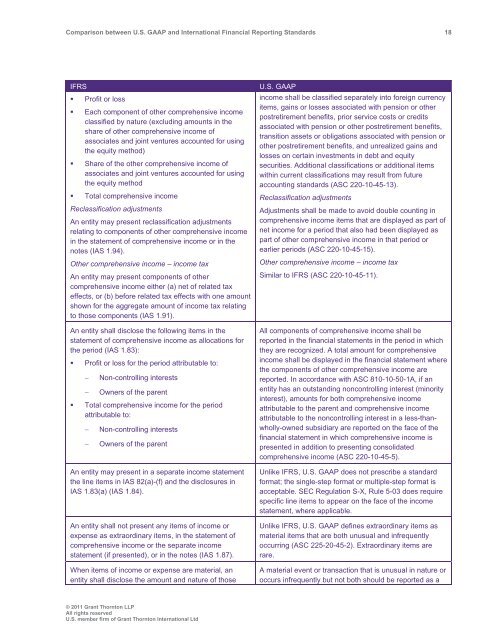Comparison between U.S. GAAP and International ... - Grant Thornton
Comparison between U.S. GAAP and International ... - Grant Thornton
Comparison between U.S. GAAP and International ... - Grant Thornton
You also want an ePaper? Increase the reach of your titles
YUMPU automatically turns print PDFs into web optimized ePapers that Google loves.
<strong>Comparison</strong> <strong>between</strong> U.S. <strong>GAAP</strong> <strong>and</strong> <strong>International</strong> Financial Reporting St<strong>and</strong>ards 18<br />
IFRS<br />
• Profit or loss<br />
• Each component of other comprehensive income<br />
classified by nature (excluding amounts in the<br />
share of other comprehensive income of<br />
associates <strong>and</strong> joint ventures accounted for using<br />
the equity method)<br />
• Share of the other comprehensive income of<br />
associates <strong>and</strong> joint ventures accounted for using<br />
the equity method<br />
• Total comprehensive income<br />
Reclassification adjustments<br />
An entity may present reclassification adjustments<br />
relating to components of other comprehensive income<br />
in the statement of comprehensive income or in the<br />
notes (IAS 1.94).<br />
Other comprehensive income – income tax<br />
An entity may present components of other<br />
comprehensive income either (a) net of related tax<br />
effects, or (b) before related tax effects with one amount<br />
shown for the aggregate amount of income tax relating<br />
to those components (IAS 1.91).<br />
An entity shall disclose the following items in the<br />
statement of comprehensive income as allocations for<br />
the period (IAS 1.83):<br />
• Profit or loss for the period attributable to:<br />
<br />
Non-controlling interests<br />
Owners of the parent<br />
• Total comprehensive income for the period<br />
attributable to:<br />
<br />
<br />
Non-controlling interests<br />
Owners of the parent<br />
An entity may present in a separate income statement<br />
the line items in IAS 82(a)-(f) <strong>and</strong> the disclosures in<br />
IAS 1.83(a) (IAS 1.84).<br />
An entity shall not present any items of income or<br />
expense as extraordinary items, in the statement of<br />
comprehensive income or the separate income<br />
statement (if presented), or in the notes (IAS 1.87).<br />
When items of income or expense are material, an<br />
entity shall disclose the amount <strong>and</strong> nature of those<br />
U.S. <strong>GAAP</strong><br />
income shall be classified separately into foreign currency<br />
items, gains or losses associated with pension or other<br />
postretirement benefits, prior service costs or credits<br />
associated with pension or other postretirement benefits,<br />
transition assets or obligations associated with pension or<br />
other postretirement benefits, <strong>and</strong> unrealized gains <strong>and</strong><br />
losses on certain investments in debt <strong>and</strong> equity<br />
securities. Additional classifications or additional items<br />
within current classifications may result from future<br />
accounting st<strong>and</strong>ards (ASC 220-10-45-13).<br />
Reclassification adjustments<br />
Adjustments shall be made to avoid double counting in<br />
comprehensive income items that are displayed as part of<br />
net income for a period that also had been displayed as<br />
part of other comprehensive income in that period or<br />
earlier periods (ASC 220-10-45-15).<br />
Other comprehensive income – income tax<br />
Similar to IFRS (ASC 220-10-45-11).<br />
All components of comprehensive income shall be<br />
reported in the financial statements in the period in which<br />
they are recognized. A total amount for comprehensive<br />
income shall be displayed in the financial statement where<br />
the components of other comprehensive income are<br />
reported. In accordance with ASC 810-10-50-1A, if an<br />
entity has an outst<strong>and</strong>ing noncontrolling interest (minority<br />
interest), amounts for both comprehensive income<br />
attributable to the parent <strong>and</strong> comprehensive income<br />
attributable to the noncontrolling interest in a less-thanwholly-owned<br />
subsidiary are reported on the face of the<br />
financial statement in which comprehensive income is<br />
presented in addition to presenting consolidated<br />
comprehensive income (ASC 220-10-45-5).<br />
Unlike IFRS, U.S. <strong>GAAP</strong> does not prescribe a st<strong>and</strong>ard<br />
format; the single-step format or multiple-step format is<br />
acceptable. SEC Regulation S-X, Rule 5-03 does require<br />
specific line items to appear on the face of the income<br />
statement, where applicable.<br />
Unlike IFRS, U.S. <strong>GAAP</strong> defines extraordinary items as<br />
material items that are both unusual <strong>and</strong> infrequently<br />
occurring (ASC 225-20-45-2). Extraordinary items are<br />
rare.<br />
A material event or transaction that is unusual in nature or<br />
occurs infrequently but not both should be reported as a<br />
© 2011 <strong>Grant</strong> <strong>Thornton</strong> LLP<br />
All rights reserved<br />
U.S. member firm of <strong>Grant</strong> <strong>Thornton</strong> <strong>International</strong> Ltd
















